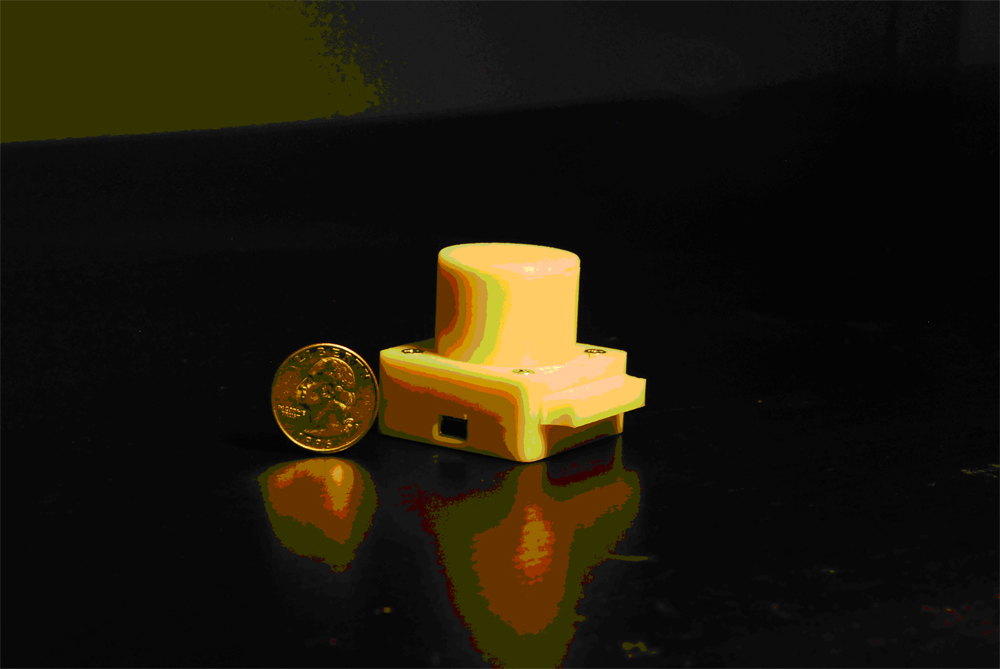Primary Goal is to Support Diagnostics and Telemedicine in Resource-Poor Regions
Imagine pathologists working with microscopes that don’t have a lens! That may be the future if technology currently under development by a UCLA engineering team can be used in various anatomic pathology or clinical laboratory applications.
UCLA engineer Aydogan Ozcan, Ph.D., introduced his newest invention, a novel lensless microscope, in the journal, Lab on a Chip. The world’s smallest, lightest microscope is about the size of a large egg and built on the LUCAS (Lensless Ultra-wide-field Cell Monitoring Array) platform previously invented by Ozcan for use in telemedicine.

This photo shows the size of UCLA Engineer Aydogan Ozcan, Ph.D.’s lensless microscope compared to the quarter placed next to it. (Photo by the Ozcan Research Group at UCLA.)
Instead of magnifying samples, LUCAS generates holographic images of micro-particles or cells. A light-emitting diode illuminates the objects, and a digital sensor array captures their images.
This powerful lensless imaging system uses an optoelectronic sensor chip to detect the classical diffraction pattern, or shadow, of micro-particles in a sample. The acquired shadow image is digitally processed using a custom-developed decision algorithm to identify the particle location in 3D and characterize each micro-particle type within the sample. Different cell types (such as red blood cells and fibroblasts) or other micro-particles exhibit uniquely different shadow patterns and, therefore, can be rapidly identified without any ambiguity.
“This is a very capable and yet cost-effective microscope, shrunk into a very small package,” stated Ozcan. “Our goal with this project was to develop a device that can be used to improve health outcomes in resource-limited settings.”
The microscope is a self-contained imaging device that only requires a USB connection to a smart-phone, PDA, or computer to supply it with power and upload images. The computer analyzes the images and produces results instantly. For certain types of diagnostic procedures in resource-limited countries or environments, this technology could eliminate the need for skilled laboratory technicians.
Samples are loaded using a small chip filled with saliva or a blood smear. The lensless microscope is capable of identifying cells and particles in blood smears, including red blood cells, white blood cells and platelets.
Ozcan and his team developed this technology with an expectation that it could transform global healthcare in remote regions of the world. The technology is simple to use and durable. This makes it ideal for monitoring diseases like malaria, HIV, and tuberculosis in places that lack healthcare facilities. Samples do not have to be scanned or perfectly aligned in the microscope. Instead, the chip simply needs to be filled with a sample, then slid into a slot on the side of the microscope. Additionally, there are few moving parts, and the large aperture is resistant to problems caused by debris that might clog the light source of Ozcan’s lensless microscope.
The LUCAS microscope also can be used to field test water quality following a hurricane, earthquake or other disaster. It can be easily converted into a differential interference contrast (DIC) microscope, also known as a Nomarski microscope, by adding a few parts that cost about $1 to $2. DIC microscopes are used to gain information on the density of a sample, giving the appearance of a 3-D image by putting lines and edges in stark contrast.
The major effort is to find applications for the lensless microscope in resource-limited settings. For example, integrated telemedicine networks that employ tools like the lensless microscope will be essential to filling gaps in physical infrastructure by connecting mobile health-care providers to a central clinical pathology laboratory or hospital.
Pathologists and clinical laboratory managers may thus see the first applications of the lensless microscope as part of telemedicine initiatives that support healthcare in more remote or underdeveloped regions.
–K. Branz
Related Information:
UCLA engineer invents world’s smallest, lightest telemedicine microscope
UCLA engineer makes lensless microscope even tinier for resource-limited settings



